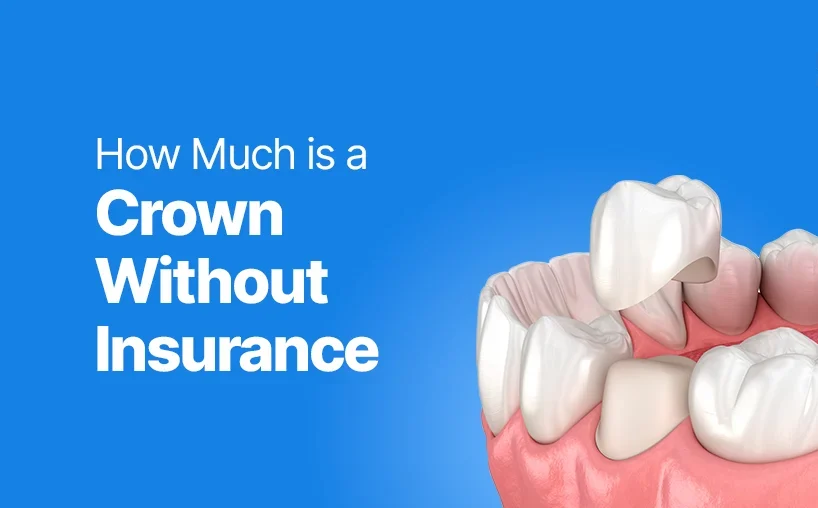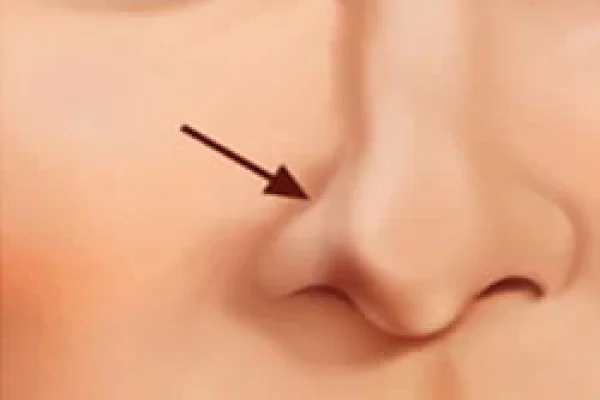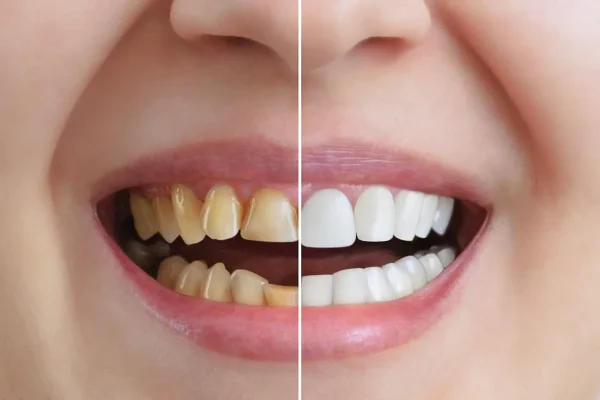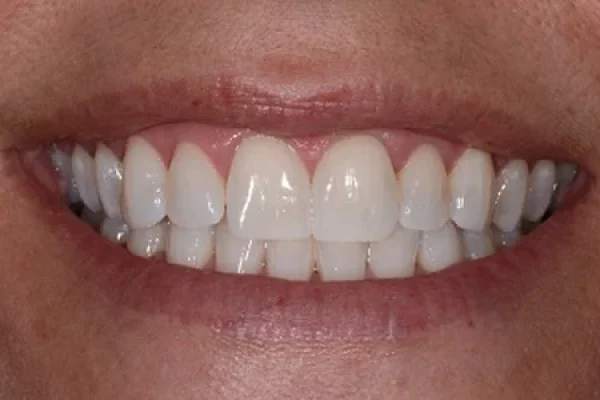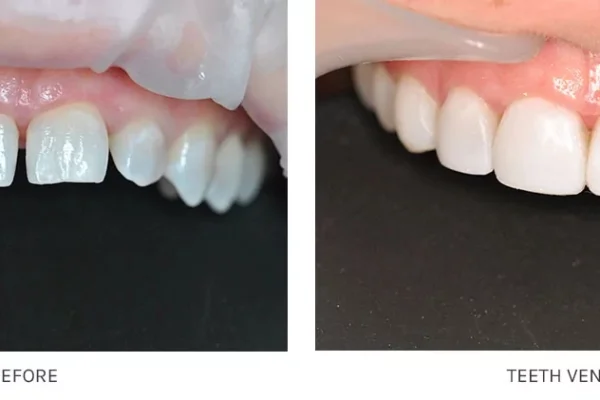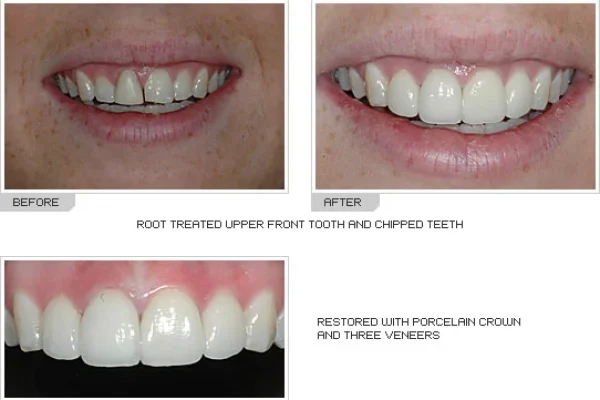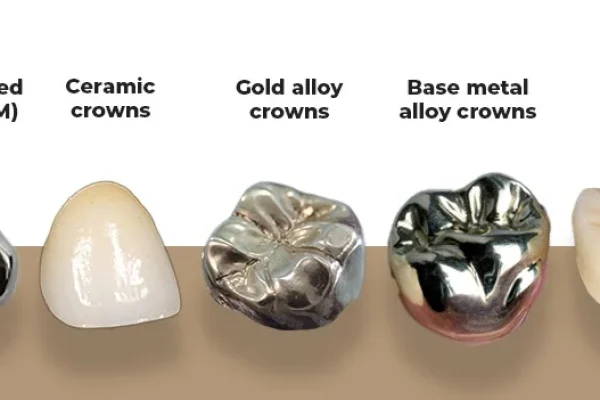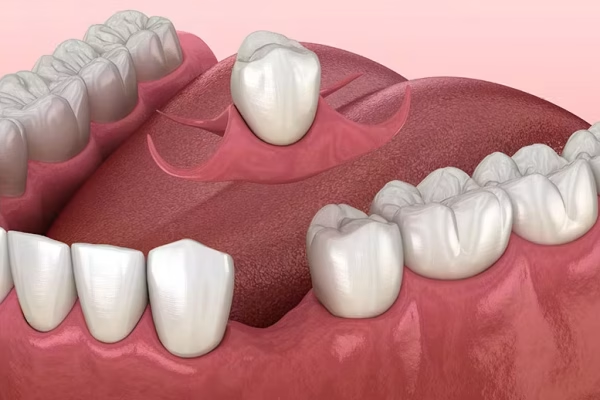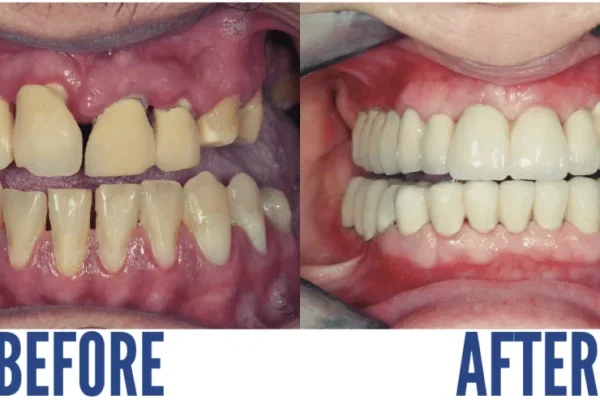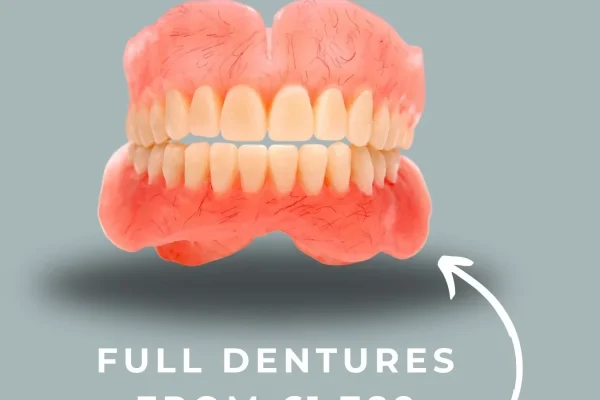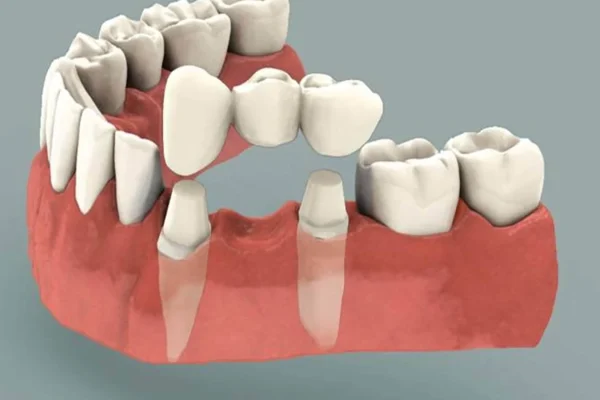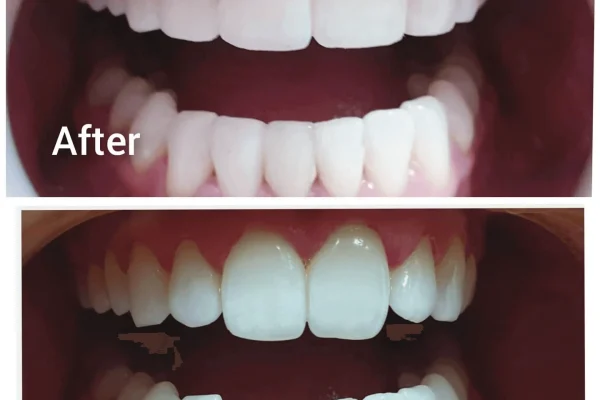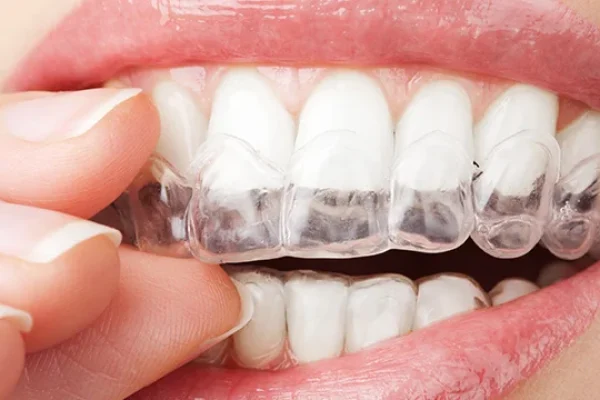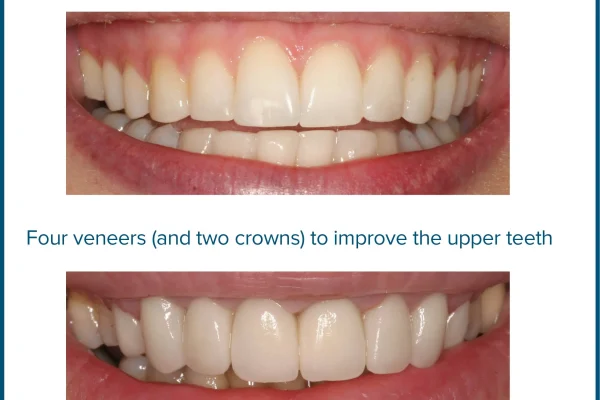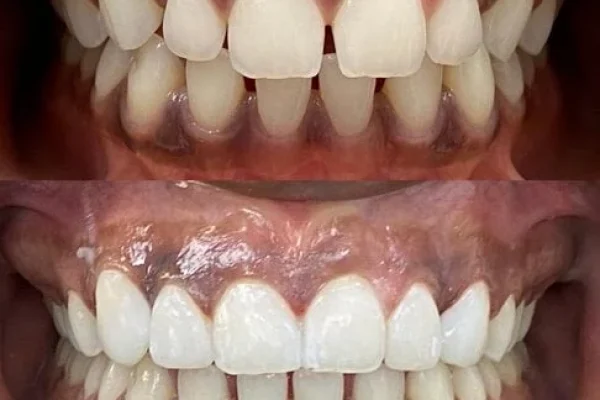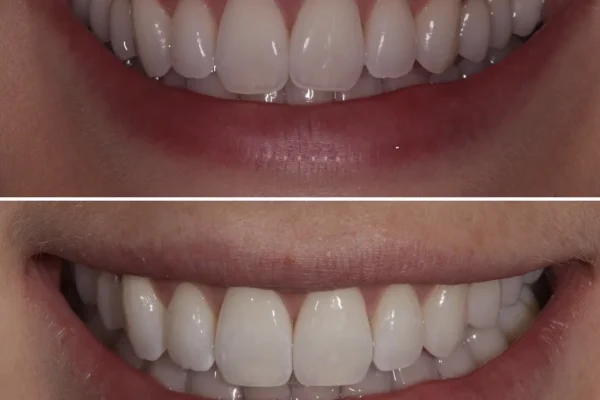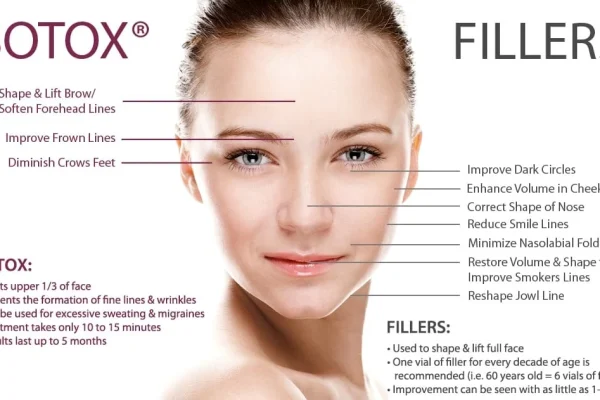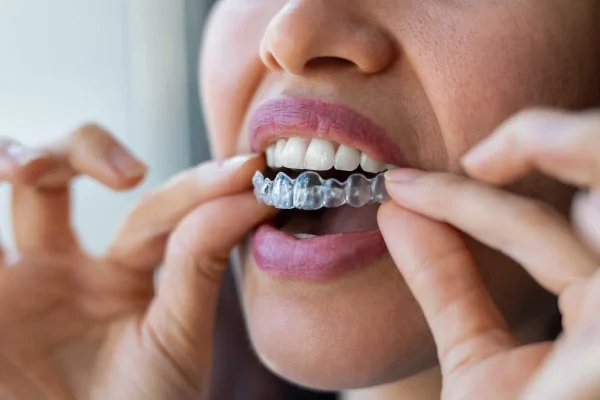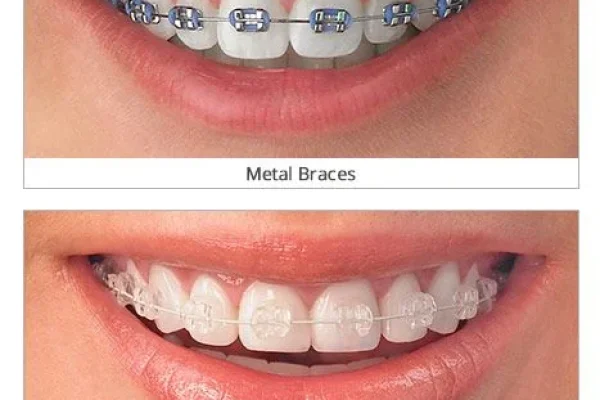
Key Takeaways
-
- Dental crown costs typically range from $800 to $2,500+ per tooth, varying widely.
-
- Key factors influencing price include: material type (porcelain, zirconia, metal, resin), dentist’s experience and clinic location, case complexity, and laboratory fees.
-
- Dental insurance often covers about 50% of the cost for medically necessary crowns, after deductibles and subject to annual maximums.
-
- More affordable options may include resin crowns, dental schools, or community clinics, but these come with specific considerations and potential trade-offs.
-
- Financing options like in-house payment plans, third-party healthcare financing (e.g., CareCredit), HSAs, and FSAs can make crowns more accessible.
- Despite the cost, dental crowns are generally considered a worthwhile long-term investment for preserving tooth function and overall oral health.
What is the Average Dental Crown Cost and How Much Should You Expect to Pay?
When you first hear the term “dental crown,” or its colloquial cousin, the “tooth cap,” one of the immediate follow-up thoughts for most people revolves around the financial commitment. So, let’s address the elephant in the room: pinning down a single, universally “average” ‘dental crown cost’ is akin to predicting the weather with absolute certainty—possible in a general sense, but subject to a multitude of local variations and specific conditions. However, we can certainly provide a ballpark, a foundational understanding from which to build your expectations. Generally, the ‘cost crown’ for a single unit can swing from a few hundred to several thousand dollars. This isn’t a vague cop-out; it’s a reflection of the highly customized nature of dental work. Terms like ‘dental crown cost’, ‘tooth cap cost’, and ‘crown cost’ are all essentially asking the same thing: what’s the ticket price for restoring this particular tooth to its former glory, or perhaps even an improved version of it? Foundational queries like “how much is a crown?”, “do crowns cost money?” (spoiler: yes, they invariably do, as they are a significant dental intervention requiring skill, materials, and time), and “what is the rates of crown?” all point to this central need for clarity. It’s crucial to understand from the outset that this “average” is merely a launchpad. The final ‘cost of dental crowns’ you encounter will be sculpted by a symphony of factors—the chosen material, the complexity of your specific dental situation, the technological sophistication of the clinic, the experience of your dentist, and even where that clinic is located. Think of the initial average as the baseline melody; the intricate harmonies and variations come from these individual components, which we will unpack thoroughly as we progress. This initial exploration is designed to set realistic expectations and to underscore why a personalized consultation with your dental professional is always the ultimate source for a precise quotation.
How Much is a Crown Per Tooth, Typically?
Focusing on the ‘cost per tooth’ is where the rubber truly meets the road for most patients considering a dental crown. When your dentist mentions that a crown is the recommended course of action for a compromised tooth, the immediate practical question becomes the individual investment for that single restoration. While we’ve established that a definitive, one-size-fits-all answer is elusive, we can certainly discuss typical price brackets. In many regions, particularly within the United States for instance, you might find that the cost for one dental crown generally ranges from approximately $800 to $2,500 per tooth. It’s a substantial range, and it’s essential to reiterate that this is an estimated spectrum. Why such a spread? Well, within this bracket, a straightforward, metal alloy crown for a less visible molar, requiring minimal preparatory work, might sit at the lower end. Conversely, a high-end, aesthetically superior all-porcelain or zirconia crown for a prominent front tooth, perhaps involving more complex digital design and milling processes (like CEREC same-day crowns), or requiring the touch of a master ceramist for perfect color matching, will naturally navigate towards the upper echelons of this range, and sometimes even exceed it. The term ‘tooth crown price’ encapsulates not just the physical cap itself, but the entire meticulous process of diagnosis, tooth preparation, impression taking (digital or traditional), temporary crown placement, the laboratory fabrication of the permanent crown, and the final fitting and cementation appointments. This ‘per tooth’ cost is a critical figure because it allows patients to budget effectively, especially if multiple crowns are needed as part of a more extensive dental rehabilitation plan. Understanding this typical range is the first step in demystifying the ‘prices for dental crowns’ and preparing for a meaningful conversation with your dental provider about your specific needs and the associated investment.
Do Crowns Cost Money, and What Does “Tooth Cap Price” Really Encompass?
Let’s be unequivocally clear: yes, dental crowns most certainly cost money. They are a significant, custom-made dental restoration, a far cry from an off-the-shelf product. They represent a substantial investment of a dental professional’s skill, time, advanced materials, and often, sophisticated laboratory technology. The notion that such a precise and durable solution could be free is, unfortunately, a misconception. When you see terms like “tooth cap price,” it’s simply another way of referring to the ‘dental crown cost.’ “Tooth cap” is a more colloquial, patient-friendly term that accurately describes the function of a crown—to cap, or cover, a damaged or weakened tooth. But what does this ‘tooth cap price’ truly encompass? It’s more than just the physical piece of porcelain, metal, or zirconia. The price reflects a comprehensive service. This typically includes the initial consultation and examination where the need for a crown is determined, any necessary diagnostic X-rays or 3D imaging, the meticulous preparation of the tooth (which involves removing decayed or damaged structure and shaping the tooth to receive the crown), the taking of precise impressions or digital scans to create a model for the lab, the fabrication and placement of a temporary crown to protect the tooth while the permanent one is being made, the skilled work of dental laboratory technicians who artfully craft your custom crown, the cost of the high-quality materials themselves, and finally, the appointment(s) to fit, adjust, and permanently cement the crown, ensuring optimal function and comfort. So, when you’re discussing the ‘cost of dental crown’, you’re really talking about a package of expert care designed to save and restore your tooth for potentially many years to come. It’s a blend of artistry, science, and healthcare, all bundled into that single “price.”
What Factors Influence the Price of a Dental Crown?
The journey to understanding the ‘cost of dental crowns’ is paved with numerous influencing factors, each playing a distinct role in shaping the final figure you’ll encounter. It’s less a fixed menu price and more a bespoke tailoring service; the “prices for dental crowns” are not standardized across the board because each patient, each tooth, and each clinical scenario presents a unique set of requirements and challenges. Think of it as a complex equation where several variables must be considered. This overview serves as a prelude, an introduction to the specific elements that we will dissect in more detail in the subsequent sections. These elements range from the tangible, such as the type of material chosen for the crown – with its inherent cost differences between, say, a resilient gold alloy and an aesthetically pleasing porcelain – to the less immediately obvious, like the geographical location of the dental practice and the prevailing local economic conditions that affect overheads. The experience and specialist credentials of the dentist performing the procedure also weigh in, as does the complexity of your individual case; a straightforward single crown is a different undertaking than one requiring extensive pre-treatment or forming part of a larger smile makeover. Furthermore, the technology utilized by the dental clinic, from digital scanners to in-house milling machines, can influence efficiency and cost. Understanding these diverse components is key to appreciating why there isn’t a one-size-fits-all answer to “how much is a crown?” and why obtaining a personalized treatment plan and quote from your dentist is paramount. This section sets the stage for a deeper dive into each specific contributor to the overall ‘tooth crown price’.
How Do Different Types of Dental Crowns Affect the Overall Cost?
The choice of material for your dental crown is undeniably one of the most significant levers affecting its overall cost, directly impacting the ‘tooth crown price’. Dental science offers a sophisticated palette of materials, each with its own unique blend of properties, aesthetics, durability, and, consequently, price point. Let’s briefly sketch out the main contenders. Porcelain crowns (or all-ceramic crowns), often lauded for their exceptional natural appearance and ability to mimic the translucency of natural tooth enamel, are a popular choice, especially for highly visible front teeth. Brands like E-max or layered porcelain fall into this category and tend to be at the mid to higher end of the cost spectrum due to the material cost and the artistry required for fabrication. Then there are Porcelain-Fused-to-Metal (PFM) crowns. These offer a hybrid solution: a strong metal substructure for durability, overlaid with porcelain for a more tooth-like appearance. They are often a more budget-friendly option than all-porcelain, providing a good balance of strength and aesthetics, though the metal margin can sometimes become visible if gums recede. Zirconia crowns have surged in popularity, prized for their immense strength and biocompatibility, making them suitable for both front and back teeth. Solid zirconia is incredibly robust, while layered zirconia can offer improved aesthetics. Their cost can be comparable to or sometimes exceed porcelain, depending on the specific type and manufacturing process. Gold alloy crowns (and other metal alloys) are the old guard, known for their exceptional durability, longevity, and kindness to opposing teeth. While not as aesthetically prominent, they are workhorses for molars. Their ‘cost crown’ can fluctuate with the market price of precious metals. Finally, resin crowns are generally the least expensive option but are also less durable and more prone to wear and staining, often considered for temporary solutions or for children’s primary teeth. Each of these materials involves different laboratory fabrication processes and associated fees, directly influencing the final ‘cost of dental crowns’.
Does the Dentist’s Experience and Clinic Location Impact Crown Prices?
Absolutely, the experience level of your dentist and the geographical location of their clinic are two pivotal, yet sometimes overlooked, factors that significantly influence ‘crown prices’. Let’s consider the dentist’s expertise first. A seasoned dentist with many years of successful crown placements, perhaps with additional postgraduate qualifications, specialist registration (like a prosthodontist, who specializes in restorations), or a reputation for handling complex cases, will understandably command higher fees. This premium reflects their advanced skill set, the reduced likelihood of complications, and often, a more refined aesthetic outcome. You’re investing in their accumulated knowledge and practiced hands. Similarly, a clinic that has invested heavily in cutting-edge technology—think CEREC machines for same-day crowns, digital intraoral scanners that replace messy impression materials, or advanced imaging systems—may have higher operational costs that are reflected in their pricing, though this technology can also offer benefits like convenience and precision. Now, turn to clinic location. The ‘cost crown’ can vary dramatically not just between countries or states, but even between a bustling urban center and a quieter rural town within the same region. A practice in a high-rent district of a major metropolitan city will inevitably have higher overheads (rent, utilities, staff salaries) than a clinic in an area with a lower cost of living. These operational expenses are naturally factored into the fees for services, including the ‘dental crown cost’. Therefore, when you search for “dental crown cost near me,” you’ll likely find a spectrum of prices directly linked to these local economic realities and the profile of the practice. It’s a complex interplay, but acknowledging these influences helps paint a fuller picture of why ‘prices for dental crowns’ aren’t uniform.
What is Typically Included in the Quoted Price for a Tooth Crown?
When your dentist provides a quoted price for a ‘tooth crown’, it’s crucial to understand what services and items are bundled into that figure to avoid any unwelcome financial surprises down the line. A comprehensive quote for a ‘dental crown cost’ should ideally be an all-inclusive package covering the entire journey from initial assessment to the final placement of your bespoke restoration. Typically, this includes: the initial consultation and diagnostic phase, which involves the dentist examining your tooth, discussing your needs, and possibly taking X-rays or digital scans to assess the tooth’s condition and supporting structures. Next is the tooth preparation appointment; this is where the dentist meticulously reshapes the existing tooth, removing any decay or damage, to create the ideal foundation for the crown. The creation and placement of a temporary crown is also usually part of the package; this provisional cap protects the prepared tooth and maintains aesthetics and function while your permanent crown is being fabricated by the dental laboratory. The cost of the dental laboratory’s work is a significant component – this covers the skilled technicians crafting your custom-made crown from the chosen material (be it porcelain, zirconia, metal, or PFM) based on the impressions or scans sent by your dentist. Naturally, the final crown itself is included. And finally, the fitting appointment(s), where the dentist removes the temporary crown, carefully checks the fit, bite, and aesthetics of the permanent crown, makes any necessary minor adjustments, and then securely bonds or cements it into place. However, it’s equally important to clarify what might not be included and could constitute additional costs. For instance, if the tooth requires a **preliminary root canal treatment** due to infection or nerve damage, this is a separate procedure with its own fee. If significant tooth structure is missing, a core build-up (essentially rebuilding the tooth’s foundation) may be necessary before the crown preparation, and this too would likely be an additional charge. Similarly, procedures like gum contouring for aesthetic or functional reasons, or more extensive diagnostic work beyond standard X-rays, might also add to the total ‘cost of crowns on teeth’. Always ask for a detailed breakdown.
Are Molar Crowns Priced Differently Than Front Teeth Crowns?
The position of the tooth in your mouth—whether it’s a hardworking molar at the back or a highly visible incisor at the front—can indeed play a role in determining the final ‘cost of dental crowns’, although it’s often intertwined with the choice of material and complexity rather than being a standalone pricing factor. For instance, the ‘price for front tooth crown’ might lean towards the higher side, not necessarily because it’s inherently more difficult to place a crown on a front tooth, but because the aesthetic demands are paramount. Achieving a perfect match in terms of color, shade, translucency, and shape to blend seamlessly with adjacent natural teeth requires a higher degree of artistry from both the dentist and the dental laboratory technician, often necessitating the use of premium all-ceramic or zirconia materials known for their superior aesthetic qualities. This focus on life-like appearance can mean more intricate lab work, custom shading, and potentially more chair time for adjustments, all of which can contribute to a higher cost. Conversely, molar crowns, while needing to be incredibly robust to withstand significant chewing forces, may not always require the same level of aesthetic finesse if they are not prominent in the smile. This might allow for the use of more traditional, highly durable yet less expensive materials like full metal alloys or strong PFM crowns, potentially leading to a comparatively lower ‘tooth crown price’ for these back teeth. However, molars can sometimes present their own challenges, such as limited access for the dentist or more complex preparation due to their anatomy. Furthermore, the amount of material required can differ; larger molars might need slightly more material than smaller incisors, though this is usually a minor factor in the overall cost compared to material type and lab fees. Ultimately, while there isn’t always a fixed price difference purely based on tooth location, the functional and aesthetic requirements dictated by the tooth’s position heavily influence material selection and the complexity of the work, which in turn directly impacts the final ‘cost crown’.
Why Can Dental Crowns Be So Expensive?
It’s a question that echoes in dental clinics across the globe: “Why is my crown so expensive?” or “Why is getting a crown so expensive?” The perception of high cost is understandable, especially when viewed as a single upfront payment. However, unpacking what goes into a dental crown reveals a complex interplay of professional skill, advanced materials science, bespoke craftsmanship, and essential operational overheads. A dental crown isn’t an off-the-shelf item; it’s a custom-engineered medical device designed specifically for your tooth. The inherent value lies in its ability to save a tooth that might otherwise be lost, restoring its function for chewing and speaking, protecting it from further damage, and often, significantly enhancing its appearance. The dentist’s role is paramount; their years of education, specialized training, and clinical experience are crucial for accurate diagnosis, meticulous tooth preparation (a highly precise skill), and the correct fitting and placement of the crown. This professional expertise is a significant component of the cost. Then there are the materials themselves – high-quality dental ceramics, zirconia, or precious metal alloys are not inexpensive. These materials are chosen for their biocompatibility, durability, and aesthetic properties. Beyond the dentist and the materials, the dental laboratory plays a critical role. Highly skilled dental technicians, often artists in their own right, use the impressions or digital scans from your dentist to fabricate the crown. This is a labor-intensive process involving precision, artistry, and often, sophisticated CAD/CAM technology. The technology itself, from intraoral scanners to in-house milling units or advanced lab equipment, represents a significant investment for the dental practice or laboratory, and the maintenance and operational costs contribute to the overall price. Finally, the comprehensive nature of the treatment, spanning multiple appointments from initial consultation and diagnosis to the final fitting and aftercare advice, all factors into the ‘cost of dental crown’. It’s an investment in preserving your natural dentition and oral health for the long term.
What are the Diagnostic and Lab Costs Contributing to the Expense?
Delving deeper into why the ‘cost of dental crowns’ can seem substantial, the diagnostic and laboratory costs emerge as two significant pillars supporting the overall expense. The diagnostic phase, while seemingly straightforward, is critical for a successful outcome. This involves more than just a quick look; it includes a thorough examination by the dentist, and often, diagnostic imaging like X-rays or, in more complex cases, 3D cone-beam computed tomography (CBCT) scans. These images are vital for assessing the health of the tooth’s root and surrounding bone, identifying any underlying issues like infection or fractures that need addressing before a crown is considered, and precisely planning the preparation. The cost of this diagnostic equipment, its maintenance, and the professional time taken to interpret the results all contribute to the initial part of the ‘dental crown cost’. Following diagnosis and tooth preparation, the impressions (whether traditional putty-based or modern digital scans) are sent to a dental laboratory. This is where a major portion of the expense is incurred. The dental lab isn’t just a factory; it’s a hub of skilled craftsmanship and advanced technology. Dental technicians meticulously create a working model from the impression, then design and fabricate the crown. This involves choosing the correct shade and material, layering porcelain for aesthetics, or milling zirconia with precision using CAD/CAM (Computer-Aided Design/Computer-Aided Manufacturing) systems. The cost of the raw materials—be it high-grade ceramic powders, zirconia blocks, or precious metal alloys—is substantial. Furthermore, the labor costs for these highly skilled technicians, who spend hours ensuring the crown has a perfect fit, contour, and occlusal (bite) relationship, are a primary driver of the ‘tooth cap price’. Quality control measures within the lab also add to the cost, ensuring the final restoration meets exacting standards before it’s returned to the dental clinic for fitting. These behind-the-scenes processes are integral to a durable and aesthetically pleasing crown, and their associated costs are a fundamental reason why ‘prices for dental crowns’ are what they are.
How Do Different Types of Dental Crowns Compare in Cost? A Detailed Look
When you’re faced with the need for a dental crown, one of the key decisions you’ll make with your dentist is the type of material to be used. This choice is a major determinant of the final ‘dental crown cost’, as each material comes with its own price tag, reflecting its manufacturing process, durability, aesthetic qualities, and the lab fees associated with its fabrication. Addressing the query, “What is the price of best tooth crown?” is nuanced, as “best” can depend on the specific tooth, the patient’s priorities (e.g., strength vs. appearance), and budget. Generally, higher-quality materials that offer superior aesthetics, biocompatibility, and longevity, or those requiring more complex fabrication techniques, will naturally command a higher price. The link between ‘types of dental crowns and cost’ is direct and significant. For instance, a basic metal crown for an out-of-sight molar will almost invariably be less expensive than a meticulously crafted, multi-layered all-porcelain crown designed for a front tooth where appearance is paramount. This section will provide an in-depth comparison, exploring the typical cost ranges and characteristics of the most common crown materials, helping you understand why a zirconia crown might be priced differently from a porcelain-fused-to-metal (PFM) option, or how a traditional gold crown stacks up in the financial stakes. By understanding these distinctions, you’ll be better equipped to discuss options with your dentist and align your choice with both your clinical needs and your financial considerations, ultimately demystifying the ‘tooth crown price’ variations.
How Much is a Porcelain Crown, and Is It a Popular Choice?
All-porcelain or all-ceramic crowns are exceptionally popular, particularly for restoring teeth that are visible when you smile, due to their remarkable ability to mimic the natural translucency, color, and overall appearance of tooth enamel. This aesthetic superiority is their hallmark. When patients ask, “how much is a porcelain crown?”, the answer typically falls into the mid to upper range of ‘dental crown costs’. You might expect to invest anywhere from $1,000 to $2,500 or even more per tooth for a high-quality porcelain crown, especially those crafted from advanced ceramic materials like E-max (lithium disilicate) or featuring intricate custom layering by a skilled ceramist for optimal aesthetics. The popularity of these crowns stems from their biocompatibility (they are metal-free, which is a plus for patients with metal sensitivities) and their excellent light-handling properties, which prevent the opaque or “flat” look that can sometimes be associated with other materials. They are a fantastic choice for front teeth – incisors and canines – where blending seamlessly with natural dentition is crucial. While historically, some older types of porcelain were considered less durable than metal-based options for high-stress areas like molars, modern dental ceramics have made significant strides in strength and fracture resistance. Materials like E-max offer a superb balance of beauty and robustness, making them suitable for a wider range of applications, including premolars and sometimes even molars, depending on the patient’s bite and habits. The cost reflects not only the price of the ceramic material itself but also the sophisticated fabrication process, which often involves CAD/CAM technology for precision milling and the artistic skill required in the dental laboratory to achieve that life-like result. So, while a porcelain ‘tooth crown price’ might be higher, many patients deem it a worthwhile investment for achieving a natural, beautiful, and long-lasting smile.
What is the Cost of Metal Crowns, Including Gold Crowns?
Metal crowns, particularly those made from gold alloys, have a long and venerable history in dentistry, prized for their exceptional durability, longevity, and biocompatibility. When considering the ‘cost of metal crowns’, it’s important to distinguish between different types. High-noble metal crowns, predominantly gold (often also containing platinum, palladium, or silver), are generally the most expensive among metal options. The question “how much is a gold crown?” doesn’t have a fixed answer because the price is directly influenced by the fluctuating market value of gold and other precious metals, as well as the percentage of noble metal in the alloy (the higher the gold content, generally the higher the cost). You could expect a gold crown to range from $800 to $2,500 or more, depending on these factors and the size of the crown. Base metal alloy crowns (e.g., nickel-chromium or cobalt-chromium) are a more economical alternative within the metal category, potentially costing between $600 and $1,500. These alloys are very strong and corrosion-resistant but may pose a risk for individuals with nickel allergies. Metal crowns are often the unsung heroes for posterior teeth—molars and sometimes premolars—where biting forces are greatest and aesthetics are less of a primary concern. Their wear characteristics are excellent, often mirroring natural tooth wear, which is gentle on opposing teeth. While their metallic appearance (silver or gold) makes them less desirable for visible areas of the mouth, their functional performance is outstanding. The ‘dental crown cost’ for metal crowns also includes the laboratory fabrication, which, while perhaps less artistically demanding than porcelain work, still requires precision casting or milling techniques. For patients prioritizing maximum durability and longevity, especially for out-of-sight back teeth, metal crowns, including gold, represent a robust and reliable, albeit sometimes pricier (for gold), investment.
What is Considered the Cheapest Crown for a Tooth?
When budget is a primary concern, patients often ask, “What is considered the cheapest crown for a tooth?” Generally, the most affordable permanent dental crown options are those made from dental resin (composite resin) or, in some specific temporary or pediatric cases, stainless steel crowns (SSCs). Resin crowns are essentially made from a tooth-colored plastic material, similar to that used for direct fillings. Their main advantage is their lower initial ‘cost crown’, which might fall in the range of $400 to $1,000 per tooth. They also offer a reasonably aesthetic match to natural teeth, at least initially. However, the trade-off for this lower price is significantly reduced durability compared to porcelain, zirconia, or metal. Resin crowns are more prone to wear and tear, fracturing, and staining over time. They typically don’t last as long as other crown types and may need replacement sooner, which could negate the initial savings in the long run. For these reasons, resin crowns are often considered more suitable for temporary restorations, for restoring children’s primary (baby) teeth, or in situations where a more definitive, durable crown is not immediately feasible. Stainless steel crowns are prefabricated metal caps, primarily used as a temporary measure for adults while a permanent crown is being made, or more commonly, as a durable and cost-effective solution for restoring decayed primary molars in children. For pediatric use, they are very effective and can cost significantly less than custom-made crowns, perhaps in the $200 to $500 range. While these “cheapest crown” options offer financial accessibility, it’s crucial to discuss their limitations and suitability for your specific long-term dental health needs with your dentist. The ‘cheapest’ upfront option isn’t always the most cost-effective over the lifespan of the restoration.
Which Type of Crown Is Typically the Most Expensive?
At the apex of the ‘dental crown cost’ spectrum, you’ll typically find crowns that combine premium materials with highly specialized fabrication techniques and exceptional aesthetic demands. Pinpointing a single “most expensive” type can be tricky as costs vary, but generally, high-end all-porcelain or all-ceramic crowns, particularly those crafted with meticulous custom layering by master dental ceramists, or those utilizing the most advanced, aesthetically superior zirconia (like high-translucency, multi-layered zirconia), often command the highest prices. These can range from $1,500 to $3,000 per tooth, and in some bespoke cosmetic dentistry cases, even more. The reasons for their higher ‘tooth crown price’ are multifaceted. Firstly, the raw materials themselves – advanced ceramic powders or top-grade zirconia blocks – are more costly. Secondly, the fabrication process is often incredibly labor-intensive and requires a high degree of artistic skill. For example, creating a porcelain crown that perfectly mimics the subtle color variations, translucency, and surface texture of a natural front tooth might involve a ceramist spending many hours layering different shades of porcelain and firing it multiple times. Similarly, designing and milling complex, aesthetically driven zirconia restorations using sophisticated CAD/CAM technology, followed by custom staining and glazing, contributes to the expense. Gold crowns, especially those with a very high gold content, can also be among the most expensive, largely due to the fluctuating market price of gold itself. If a crown involves particularly complex aesthetic work, such as matching a single central incisor (one of the most challenging tasks in cosmetic dentistry), or is part of a full smile makeover, the overall ‘cost of dental crowns’ for such treatments will naturally be at the premium end. These expensive options aim to deliver not just function but unparalleled aesthetics and biocompatibility, often representing the pinnacle of dental restorative art and science.
How Does Dental Insurance Affect What You Pay for Crowns?
Dental insurance can feel like a financial life raft when facing the ‘cost of crowns on teeth’, but understanding its intricacies is key to truly gauging its benefits. The good news is that many dental insurance plans do offer some level of coverage for dental crowns, especially when they are deemed medically necessary for restoring a tooth’s function and health, rather than being purely cosmetic. However, the extent of this coverage can vary as widely as the ‘prices for dental crowns’ themselves. Common patient questions like “Are dental crowns covered by insurance?” and “Does dental insurance cover the cost of dental crowns?” usually receive a “yes, but…” type of answer. The “but” encompasses a range of factors: the specifics of your individual plan, your annual maximum benefit, any deductibles you need to meet, co-payment percentages, and potential waiting periods for major restorative procedures like crowns. Some plans might cover a certain percentage of the “usual, customary, and reasonable” (UCR) fee for a crown, often around 50%, but this UCR fee might be lower than your dentist’s actual charge, leaving you to cover the difference plus your co-payment. It’s also important to know if your plan has limitations on the type of crown material covered (e.g., they might cover a PFM crown at a certain rate but not fully cover a more expensive all-porcelain option if a PFM is deemed clinically adequate). Navigating these details requires a close look at your policy documents or a direct conversation with your insurance provider. Your dentist’s office can often help by submitting a pre-treatment estimate to your insurer, which provides a clearer picture of your out-of-pocket expenses before you commit to the procedure. This proactive step is invaluable in managing the financial aspect of your ‘dental crown cost’.
What is the Dental Crown Cost Without Insurance?
Facing the ‘dental crown cost without insurance’ means you’ll be responsible for the full, unadulterated price of the procedure. This is often referred to as the “cash price” or the “self-pay rate.” In this scenario, the price ranges we’ve discussed earlier—typically $800 to $2,500 per crown, and sometimes higher depending on material, complexity, and location—become your direct financial responsibility. Without the buffer of an insurance plan contributing a percentage or a negotiated rate, the entire ‘cost of dental crowns’ falls to you. This can be a significant outlay, especially if multiple crowns are needed. However, being an uninsured patient doesn’t necessarily mean you have no leverage or options. Many dental practices offer a slight discount for patients paying in full at the time of service, as it reduces their administrative overhead associated with processing insurance claims. It’s always worth inquiring about this possibility. Furthermore, even without traditional insurance, you might explore options like in-house dental savings plans offered by some clinics, third-party dental discount plans (which offer reduced fees on various procedures for an annual membership fee), or financing options, which we’ll discuss later. Understanding the full ‘tooth cap price’ upfront is critical for uninsured patients to plan and budget accordingly. Your dentist should provide a clear, itemized estimate of all associated costs before treatment begins, allowing you to make an informed decision and explore any available payment arrangements or assistance programs. While the prospect of covering the full cost can be daunting, remember that a crown is an investment in preserving your tooth and preventing more complex and potentially more expensive problems in the future.
How Much Should a Crown Cost With Insurance, and What Coverage Can You Typically Expect?
Determining “how much should a crown cost with insurance” requires a dive into the specifics of your individual dental plan, as coverage is far from uniform. Typically, dental insurance categorizes crowns as a “major” restorative procedure. For such procedures, a common coverage level is around 50% of the insurance company’s allowed amount for the service. So, if your insurer’s allowed amount for a particular type of crown is $1,200, they might pay $600, and you’d be responsible for the remaining $600, plus any applicable deductible. However, several key terms come into play. Your deductible is the amount you must pay out-of-pocket for covered services before your insurance starts contributing. For example, if you have a $100 deductible and haven’t met it yet, you’d pay that first $100 towards the crown cost before the 50% coverage kicks in. Then there’s the annual maximum, which is the most your insurance plan will pay for all your dental care in a plan year (e.g., $1,500 or $2,000). If the cost of your crown, or crowns, combined with other dental work, exceeds this maximum, you’ll pay the difference. Some plans also have waiting periods for major services like crowns, meaning you must be enrolled in the plan for a certain duration (e.g., 6-12 months) before you’re eligible for coverage on these procedures. Furthermore, insurers often have a “schedule of allowances” or “usual, customary, and reasonable” (UCR) fees, which might be lower than your dentist’s actual fees, especially if your dentist is out-of-network. In such cases, you’d be responsible for your co-payment plus the difference between the dentist’s fee and the insurer’s allowed amount. The best approach is to obtain a pre-treatment estimate (or pre-determination of benefits) from your insurance company through your dentist’s office. This document will outline what your plan is expected to cover for your specific ‘dental crown cost’, giving you a much clearer picture of your out-of-pocket responsibility.
What is the Difference in Crown Cost When Using an In-Network vs. Out-Of-Network Dentist?
The difference in ‘dental crown cost’ when using an in-network versus an out-of-network dentist can be quite significant, and it’s a crucial factor for insured patients to consider. Dental insurance plans, particularly Preferred Provider Organizations (PPOs), establish a network of dentists who have agreed to provide services to plan members at pre-negotiated, often discounted, rates. When you choose an in-network dentist, you benefit from these negotiated fees. Your insurance company will pay its share based on this lower, contracted rate, and your co-payment (your portion of the bill) will also be calculated from this reduced amount. This generally results in lower out-of-pocket expenses for your ‘tooth crown price’. For example, if an in-network dentist’s negotiated fee for a crown is $1,200 and your insurance covers 50%, you’d pay $600 (plus any deductible). Conversely, if you opt for an out-of-network dentist, they have not agreed to any specific fee schedule with your insurance company. They can charge their standard fees for services. Your insurance plan might still provide some coverage for out-of-network care, but it’s often at a lower percentage, and more importantly, it will be based on what the insurance company deems a “usual, customary, and reasonable” (UCR) fee for that service, which might be considerably less than the out-of-network dentist’s actual charge. If the out-of-network dentist charges $1,500 for the same crown, and your insurance’s UCR is $1,000, they might still pay 50% of that $1,000 (i.e., $500), leaving you responsible for the remaining $500 plus the $500 difference between the dentist’s charge and the UCR, totaling $1,000 out-of-pocket. This practice is sometimes called “balance billing.” Some Health Maintenance Organization (HMO) dental plans may not offer any coverage for out-of-network care, except in emergencies. Therefore, staying in-network is usually the most cost-effective way to manage your ‘cost of dental crowns’ if you have PPO insurance.
Does Medicare or Specific Insurers like Delta Dental Cover Dental Crown Placement?
When considering coverage for ‘dental crown cost’, it’s essential to look at specific insurers and programs, as policies vary widely. Let’s start with Medicare. Traditional Medicare (Part A and Part B) generally does not cover routine dental care, which includes most dental crowns. Medicare might cover certain dental services if they are an integral part of another covered medical procedure (e.g., jaw surgery due to an accident), but for standard dental crown placements needed due to decay or tooth damage, you typically won’t find coverage under original Medicare. However, some Medicare Advantage Plans (Part C), which are offered by private insurance companies approved by Medicare, may include benefits for routine dental services, potentially including crowns. If you have a Medicare Advantage Plan, you’d need to check your specific plan documents or contact the provider to understand any coverage for ‘prices for dental crowns’. Now, let’s consider a major private dental insurer like Delta Dental. Delta Dental offers a wide array of plans, and many of these do provide coverage for dental crowns, often classifying them as a Class III or Major Restorative service. The extent of coverage—the percentage paid, applicable deductibles, annual maximums, and any limitations on material types or waiting periods—will depend entirely on the specific Delta Dental plan an individual or employer has selected. For instance, one Delta Dental PPO plan might cover crowns at 50% after a deductible, while another might offer a different percentage or have different network rules. To know for sure if your Delta Dental plan (or any other private insurance plan) covers ‘tooth crown price’ and to what extent, the most reliable approach is to review your benefits booklet, log into your member portal on their website, or call their customer service line. Your dentist’s office can also usually assist by submitting a pre-treatment estimate to Delta Dental to clarify your expected out-of-pocket expenses.
Are There Ways to Find Affordable Dental Crowns or Save Money on Treatment?
The ‘cost of dental crowns’ can indeed be a significant financial consideration, prompting many to search for ways to find more affordable options or implement ‘cost-saving strategies’. While quality dental care is an investment in your long-term health, there are legitimate avenues to explore that might help manage the expense without compromising the integrity of the treatment. If you find yourself thinking, “What happens if I can’t afford a crown?”, know that you’re not alone, and there are proactive steps you can take. The first and most crucial step is open communication with your dental provider. Discuss your budget concerns frankly; many dentists are willing to work with patients to find solutions, whether it’s phasing treatment, discussing different material options that might be more cost-effective yet clinically appropriate, or offering payment plans. Beyond direct discussions with your current dentist, this section will explore various practical approaches, from comparing prices and considering different types of dental facilities to leveraging discount plans or exploring financing. The goal is to empower you with information so you can navigate the financial aspects of your dental crown treatment more confidently and find a path that aligns with both your oral health needs and your budget. Remember, seeking “affordable” doesn’t mean seeking “cheap” at the expense of quality; it means finding the best value and a manageable financial solution for necessary care.
What are Cheaper Alternatives to a Tooth Crown, if Any?
When faced with the ‘dental crown cost’, it’s natural to wonder, “What are cheaper alternatives to a tooth crown?” While a dental crown is often the optimal and most durable solution for significantly damaged, weakened, or structurally compromised teeth, there are situations where other, less expensive treatments might be considered, depending on the specific clinical scenario. For instance, if a tooth has a large cavity but still retains sufficient healthy structure, a **large dental filling** (amalgam or composite resin) could be an option. Fillings are generally less expensive than crowns because they involve less tooth preparation and no laboratory fabrication. However, if the cavity is too extensive or if cusps are fractured, a filling may not provide adequate strength and protection, potentially leading to tooth fracture later on. Another alternative for posterior teeth with moderate damage, not quite warranting a full crown, could be an **inlay or an onlay**. These are indirect restorations, meaning they are fabricated in a dental lab (like a crown) but cover only a portion of the tooth – an inlay fits within the cusps, while an onlay covers one or more cusps. They are more conservative than full crowns as they preserve more natural tooth structure and are generally less expensive than a full crown, though more costly than a direct filling. For purely aesthetic concerns on front teeth, such as chips or discoloration, **dental bonding** (applying a tooth-colored resin directly to the tooth) or **veneers** (thin porcelain shells) might be alternatives, though veneers themselves can be comparable in cost to crowns. It’s crucial to understand that these alternatives are not always suitable substitutes. A crown is specifically designed to encase and protect a tooth that is at high risk of fracture or has lost substantial structure. Your dentist is the best person to determine if a less extensive, and therefore potentially cheaper, alternative is clinically appropriate for your situation. Opting for a less robust solution when a crown is truly indicated could lead to more complex and costly problems down the line if the tooth fails.
How Can You Effectively Compare Prices for Dental Crown Treatments?
Effectively comparing ‘prices for dental crowns’ involves more than just calling a few clinics and asking for a ballpark figure. To make an informed decision and potentially find a more affordable ‘dental crown cost’, a more methodical approach is beneficial. Firstly, **seek second opinions or multiple quotes**, especially if the recommended treatment is extensive or costly. Don’t hesitate to schedule consultations with two or three different dental practices. During these consultations, ensure you receive a detailed written treatment plan that clearly itemizes what’s included in the quoted ‘cost crown’. This is vital because a lower headline price might not be a bargain if it excludes essential components like diagnostic X-rays, the temporary crown, or follow-up adjustments, which could then be billed separately. When comparing quotes, **look beyond the bottom-line price**. Consider what type of crown material is being proposed (e.g., PFM, all-porcelain, zirconia, gold) as this significantly impacts cost and longevity. Ask about the laboratory used for fabrication – is it a reputable lab known for quality work? Inquire about the dentist’s experience with the specific type of crown recommended. You should also factor in the technology used by the clinic; for example, does the practice offer CEREC same-day crowns, which might have a different cost structure but offer convenience? While comparing, also **consider dentist experience and patient reviews**. A slightly higher price from a highly reputable dentist with excellent reviews and a portfolio of successful cases might offer better long-term value and peace of mind than the absolute cheapest option. Finally, if you have dental insurance, understand how each clinic works with your plan (in-network vs. out-of-network status) as this will dramatically affect your out-of-pocket expenses. By being thorough and asking detailed questions, you can make a more meaningful comparison of the true value offered, not just the ‘tooth cap price’.
Are Dental Schools or Community Clinics Viable Options for Lower Crown Costs?
Yes, accredited dental schools and community dental clinics can indeed be viable options for patients seeking a more affordable ‘dental crown cost’, although they come with their own set of considerations. Dental schools often provide services at a significantly reduced rate compared to private dental practices. This is because treatments are typically performed by dental students under the close supervision of experienced, licensed faculty members. The lower ‘cost of dental crowns’ at these institutions reflects the educational setting; you are contributing to a student’s learning experience. Procedures at dental schools may take longer than in a private office, as students work meticulously and are frequently checked by their supervisors. Appointment availability might also be more limited, and there could be waiting lists for certain treatments. However, the quality of care is generally high due to the stringent supervision and the use of current techniques and materials. This can be an excellent way to access complex treatments like crowns at a fraction of the usual ‘prices for dental crowns’. Community dental clinics or public health facilities are another avenue. These clinics often operate on a non-profit basis or receive government funding, allowing them to offer services at lower fees, sometimes on a sliding scale based on income. Their primary mission is to provide accessible dental care to underserved populations. While they may not always offer the most advanced cosmetic options, they can provide essential restorative treatments, including crowns, at a more manageable ‘tooth cap cost’. Similar to dental schools, there might be waiting times, and the range of material choices could be more limited than in a private cosmetic practice. When considering these options, it’s important to inquire about their specific services, eligibility criteria, fee structures, and the experience level of the providers. For many, the trade-off of potentially longer appointments or less choice in materials is well worth the substantial cost savings.
Are Tooth Crowns Worth the Money in the Long Run?
When you’re looking at a potential bill for a ‘dental crown cost’, it’s perfectly natural to ask, “Are tooth crowns worth the money?” From a purely functional and long-term oral health perspective, the answer is overwhelmingly yes, in most cases where they are professionally recommended. A dental crown is not merely a cosmetic enhancement; it’s a crucial restorative procedure designed to salvage a tooth that might otherwise be destined for extraction. Losing a tooth can trigger a cascade of more complex and expensive problems, including shifting of adjacent teeth, bite issues, difficulty chewing, and bone loss in the jaw. The ‘cost of dental crowns’, when weighed against the potential future costs of tooth replacement options like bridges or dental implants (which are significantly more expensive), often makes the crown a sound financial investment. Crowns restore the tooth’s original function, allowing you to chew properly and speak clearly. They provide a protective shield for a tooth that has been weakened by extensive decay, a large filling, a fracture, or a root canal treatment, preventing further damage and potential infection. Aesthetically, a well-crafted crown can dramatically improve the appearance of a discolored, misshapen, or broken tooth, boosting confidence and quality of life. Furthermore, dental crowns are designed for longevity. With proper oral hygiene and regular dental check-ups, a quality crown can last for many years, often 10 to 15 years or even longer, making the initial ‘tooth crown price’ a long-term investment spread over its lifespan. When you consider “how much is a crown worth today?”, think beyond the immediate expense and consider its role in preserving your natural dentition, maintaining your overall oral health, and preventing more significant dental expenditures in the future.
How Does Location Influence the Overall Cost of Dental Crowns?
The geographical location of a dental practice plays a surprisingly significant role in determining the overall ‘cost of dental crowns’, reflecting fundamental economic principles that affect service industries everywhere. Just as the price of housing or a cup of coffee can vary dramatically from one city or region to another, so too can the ‘prices for dental crowns’. Several interconnected factors contribute to these regional variations. Firstly, the regional cost of living is a major driver. In areas with a higher cost of living, dental practices face higher operational expenses – rent or mortgage payments for their clinic space are more expensive, staff salaries (for hygienists, assistants, and administrative personnel) need to be competitive with local wage scales, and utility costs can be greater. These increased overheads are inevitably factored into the fees charged for dental procedures, including the ‘tooth cap price’. Secondly, average local incomes can indirectly influence pricing, as dental fees often align with what the local market can bear. Urban centers and affluent suburban areas typically see higher dental costs compared to rural communities or less economically developed regions. Furthermore, the concentration of dental practices and level of competition in an area can also have an impact, although this can sometimes work in both directions – high competition might drive prices down, or it might foster an environment where clinics differentiate themselves by offering premium services at premium prices. The availability and cost of specialized dental laboratories in a region can also influence the lab fees that dentists incur and pass on. Therefore, when you research ‘dental crown cost’, you’ll quickly find that “near me” can mean very different things depending on whether “me” is in downtown Manhattan or a small town in the Midwest.
What is the Typical Cost of Dental Crowns in the UK?
Navigating the ‘cost of dental crowns in the UK’ requires understanding the distinction between National Health Service (NHS) dental charges and private dental fees, as these can differ substantially. If you’re eligible for NHS dental treatment, crowns fall under Band 3, which is the highest fixed charge category for NHS dental treatments in England. As of late 2023/early 2024, the Band 3 charge is £319.10 in England. This single charge covers all treatment necessary to complete the course, which could include multiple crowns if clinically required. Wales, Scotland, and Northern Ireland have their own NHS charging structures, which may vary slightly. It’s important to note that NHS crowns are provided based on clinical necessity, and the choice of materials might be more limited, often focusing on functionality (e.g., non-precious metal alloys for back teeth, or basic porcelain-fused-to-metal for more visible teeth). The primary aim is to secure oral health. However, if you opt for a private dental crown in the UK, the ‘teeth crowns cost uk’ or ‘dental crown price uk’ will be significantly higher and more variable. Private ‘crown cost uk’ can range anywhere from approximately £400 to over £1,500 per tooth, and sometimes even more for highly specialised cosmetic work or premium materials like high-grade zirconia or all-porcelain crowns from elite laboratories, particularly in major cities like London. Private treatment offers a wider choice of materials, often prioritising aesthetics alongside function, and may provide access to more advanced technologies or dentists with specific cosmetic expertise. Factors influencing private costs include the clinic’s location (London practices are generally more expensive), the dentist’s experience, the complexity of the case, and the specific type of crown chosen. So, while the NHS provides a very affordable route for clinically necessary crowns, private options offer greater choice and aesthetic refinement at a correspondingly higher price point.
How Much Might a Dental Crown Cost in Specific US Cities like NYC or Other International Hubs like Melbourne?
The ‘dental crown cost’ can exhibit dramatic variations when comparing specific major US cities like New York City (NYC) with other international hubs such as Melbourne, Australia, underscoring the impact of local economies and healthcare systems. In NYC, a city known for its high cost of living and operational expenses, you can expect ‘prices for dental crowns’ to be at the higher end of the US national average, and often exceeding it. A single crown in Manhattan or other prime NYC boroughs could easily range from $1,500 to $3,500 or even more, particularly if you’re seeking treatment from a top-tier cosmetic dentist or requiring advanced materials like high-translucency zirconia or custom-shaded porcelain. The overheads for dental practices in NYC—rent, staff salaries, insurance—are substantial, and these are reflected in patient fees. Now, let’s hop across the globe to Melbourne, Australia. While still a major international city with a high quality of life, the dental pricing landscape differs. The ‘cost of dental crowns’ in Melbourne might typically range from AUD $1,200 to AUD $2,500 per tooth (approximately USD $800 to USD $1,650, subject to exchange rate fluctuations). Factors influencing this range in Melbourne are similar to those elsewhere: the material used (porcelain, zirconia, gold), the complexity of the procedure, and the dentist’s experience. Australia has a mixed public-private dental system; while basic dental care might be subsidized for certain eligible groups, most adults access dental care, including crowns, through private practices and may use private health insurance to help cover costs. Private health insurance rebates for crowns in Australia vary significantly depending on the level of cover. Comparing these two cities highlights that while the fundamental components of a ‘tooth cap price’ (materials, lab work, dentist’s skill) are universal, local economic conditions, practice overheads, and the structure of the local healthcare and insurance systems create distinct pricing environments globally.
What Are Some Specific Cost Considerations for Dental Crowns?
Beyond the general factors like material type and clinic location, there are several specific cost considerations that can significantly influence the final ‘dental crown cost’ you encounter. These nuances often arise from an individual patient’s unique dental situation, the treatment pathway chosen, or the need for adjunctive procedures. Understanding these specific scenarios is crucial for comprehensive financial planning and for having a clear dialogue with your dentist about the total expected investment in your oral health. For instance, the decision to opt for purely private treatment versus exploring options within a national health service (where available and applicable) or leveraging dental insurance will create different financial outcomes. Similarly, if a tooth requiring a crown also needs a root canal, this becomes a combined treatment with a cumulative cost. This section aims to group together these more particular circumstances, acknowledging that individual needs play a huge role in shaping the total expense. By shedding light on these specific considerations, we can help you anticipate potential additional costs and understand why your ‘prices for dental crowns’ might differ from a standard estimate, ensuring you’re well-prepared for the financial aspects of your specific treatment journey.
How Much is a Private Crown Compared to Other Options, Such as NHS or Insurance-Covered?
When patients ask, “how much is a private crown?”, they are typically trying to understand the cost of treatment received outside of any national health service (like the UK’s NHS) or without the direct financial assistance of a comprehensive dental insurance plan that significantly reduces out-of-pocket expenses. A ‘private crown’ generally implies a fee-for-service arrangement where the patient covers the full cost, often with a greater choice of materials, dentists, and potentially faster appointment scheduling compared to publicly funded systems. The cost difference can be substantial. For example, as previously mentioned, an NHS crown in England might have a fixed patient charge (e.g., around £319.10 as of early 2024), whereas a private ‘dental crown cost’ in the UK could range from £400 to £1,500+ per tooth. The factors driving this higher private cost include the use of premium materials (e.g., high-aesthetic all-porcelain or zirconia, gold), access to dentists with specialized cosmetic training, more time allocated per patient, and often, the use of private dental laboratories known for superior craftsmanship. Compared to an insurance-covered crown in a system like the US, a “private” or self-pay patient would bear the full fee quoted by the dentist. If insured, that same fee might be reduced by a negotiated PPO rate, and then a percentage (commonly 50%) covered by the insurer, significantly lowering the patient’s direct ‘tooth cap price’. So, if a dentist’s standard fee for a crown is $1,500, an uninsured (private) patient pays $1,500. An insured patient (assuming the $1,500 is also the in-network negotiated rate, and after any deductible) might pay $750. The allure of private treatment often lies in enhanced choice, aesthetics, and potentially a more personalized experience, but this comes at a premium compared to subsidized or insurance-negotiated pathways.
How Much Does a Root Canal and Crown Cost When Done Together?
It’s a common scenario in dentistry: a tooth that is severely decayed, infected, or traumatized may require both a root canal treatment to save the tooth’s core and a dental crown to protect and restore its structure and function afterwards. When these two procedures are necessary, patients understandably want to know “how much does a root canal and crown cost” when done together. It’s essential to understand that these are two distinct procedures, each with its own associated fees, and the total cost will be the sum of both. A root canal treatment involves removing the infected or inflamed pulp from inside the tooth, cleaning and disinfecting the root canals, and then filling and sealing them. The cost of a root canal varies depending on which tooth is affected (molars with multiple canals are more complex and thus more expensive than front teeth with a single canal) and whether it’s performed by a general dentist or a specialist endodontist. A root canal might range from $700 to $2,000 or more. Following the root canal, the tooth is often significantly weakened and requires a crown for long-term protection against fracture. The ‘dental crown cost’ will then be added, which, as we’ve discussed, can range from $800 to $2,500+. Therefore, the combined ‘cost of dental crowns’ and root canals can easily range from $1,500 to $4,500 or even higher, especially if you are paying without insurance (“how much root canal and crown cost (without insurance)” is a critical question for many). It’s vital for patients to receive a clear, itemized treatment plan from their dentist that outlines the costs for both the root canal procedure and the subsequent crown placement separately, allowing for transparent understanding of the total financial commitment involved in saving the tooth.
What Financing Options Are Available if You Need Help Paying for Dental Crowns?
The ‘dental crown cost’ can sometimes feel like a steep hill to climb, especially if multiple crowns are needed or if the treatment comes at an unexpected time. Fortunately, if the upfront ‘prices for dental crowns’ are a concern, there are several financing options available that can help make the treatment more financially manageable, ensuring you don’t have to delay necessary care. Addressing the common question, “Are there any financing options available for dental crown costs?” with a resounding “yes” can offer significant peace of mind. Dental practices are increasingly aware of the financial pressures patients can face and often provide or facilitate various solutions to spread out the payments. From in-house arrangements to third-party lenders specializing in healthcare, the goal is to break down a potentially large sum into smaller, more digestible installments. This section will explore the most common avenues patients can pursue to finance their dental crown treatment, enabling them to access the care they need without undue immediate financial strain. Understanding these options allows you to proactively discuss financial arrangements with your dental office and choose a path that best suits your budget and circumstances, making that essential ‘tooth cap price’ more accessible.
Can You Arrange Payment Plans Directly With Your Dentist’s Office?
Yes, many dental practices understand that the upfront ‘dental crown cost’ can be a hurdle for patients and therefore offer in-house payment plans directly through their office. This can be a convenient and often straightforward way to manage the expense. These plans allow you to spread the ‘cost of dental crowns’ over a set period, typically ranging from a few months to sometimes a year or slightly more, through a series of regular installments. The specifics of these in-house plans vary significantly from one practice to another. Some dentists may offer short-term plans (e.g., 3-6 months) that are interest-free, provided you make all payments on time. For longer terms, a low-interest rate or an administrative fee might be applied. To arrange such a plan, you’ll usually discuss it with the practice manager or financial coordinator. They will outline the terms, including the required down payment (if any), the number of installments, the amount of each payment, and any associated fees or interest. It’s crucial to get all the terms in writing and ensure you understand your obligations before committing. In-house payment plans can be particularly helpful if you don’t qualify for or prefer not to use third-party credit options. They foster a direct financial relationship with your dental provider. When inquiring about the ‘tooth cap price’, always ask if the office offers any internal financing or phased payment options. This proactive approach can make a significant difference in your ability to budget for necessary dental treatment without excessive immediate financial stress, making that essential restoration more accessible.
Are Third-Party Healthcare Financing Companies an Option?
Absolutely, third-party healthcare financing companies are a widely available and commonly used option for patients looking to manage the ‘dental crown cost’ and other medical or dental expenses. Companies like CareCredit, LendingClub Patient Solutions (formerly Springstone), and others specialize in providing credit lines or loans specifically for healthcare procedures, including dental work like crowns. These companies work by paying your dentist upfront for the full ‘cost of dental crowns’, and then you, the patient, make monthly payments to the financing company over an agreed-upon term. One of the main attractions of these services is that they often offer promotional financing periods, such as 6, 12, 18, or even 24 months, during which no interest is charged if the full balance is paid off within that promotional timeframe. This can be a very appealing way to spread out the ‘prices for dental crowns’ without incurring additional interest costs. However, it’s critically important to understand the terms: if the balance isn’t paid in full by the end of the promotional period, deferred interest (often at a high rate) may be applied retroactively from the original purchase date. For longer repayment terms beyond the promotional no-interest periods, standard interest rates will apply. You typically apply for these credit lines either online or through your dentist’s office, and approval is based on your creditworthiness. Before signing up, carefully review the interest rates, fees, and the conditions of any promotional offers to ensure it’s a suitable financial solution for your needs. These third-party financiers can make even significant ‘tooth cap price’ figures much more manageable by breaking them into predictable monthly payments.
What Other Financial Assistance or Resources Might Be Available?
Beyond direct payment plans with your dentist or third-party healthcare financing, there are several other financial assistance avenues and resources that might help you manage the ‘dental crown cost’. If you have a Health Savings Account (HSA) or a Flexible Spending Account (FSA) through your employer, these can be excellent tools. HSAs and FSAs allow you to set aside pre-tax dollars for eligible healthcare expenses, which typically include dental crowns. Using these funds effectively reduces your taxable income and allows you to pay for your ‘cost of dental crowns’ with tax-advantaged money. Check the specifics of your plan for contribution limits and eligible expenses. Another option to explore is dental discount plans (also known as dental savings plans). These are not insurance, but rather membership-based plans where you pay an annual fee to get access to a network of dentists who offer their services at discounted rates, often 10-60% off standard fees. This can significantly reduce the ‘prices for dental crowns’. Ensure the plan you consider has participating dentists in your area and offers good discounts on major restorative work like crowns. For individuals facing significant financial hardship, some charitable organizations or dental assistance programs may offer help, though these are often very specific in their eligibility criteria and may have long waiting lists. It’s worth researching local or national dental charities. In some cases, especially for extensive dental work, a personal loan from a bank or credit union might offer a lower interest rate than some specialized healthcare credit options, although this depends on your credit score and relationship with the financial institution. Finally, don’t underestimate the value of a frank discussion with your dentist about your financial situation; they may be aware of local resources or be willing to offer a cash discount for upfront payment, which can also help alleviate the ‘tooth cap price’.
What Should You Consider Overall Before Getting a Dental Crown, Including Cost?
Deciding to proceed with a dental crown is a significant step towards restoring your oral health and smile, but it’s a decision that warrants careful consideration of several interconnected factors, with the ‘dental crown cost’ being a prominent one. Before you commit, it’s essential to have a comprehensive understanding of not just the financial implications, but also the clinical necessity, the procedure itself, potential alternatives, and the long-term benefits and maintenance. A thorough consultation with your dentist is the cornerstone of this process. This is your opportunity to ask detailed questions and ensure you are making a fully informed choice. Your dentist should clearly explain why a crown is being recommended for your specific tooth – is it due to extensive decay, a fracture, to protect a tooth after root canal treatment, or for significant aesthetic improvement? Understanding the rationale is key. You should also discuss any potential alternative treatments, their pros and cons, and why a crown is considered the most suitable option in your case. Explore the different types of crown materials available (porcelain, zirconia, PFM, gold) and understand how each aligns with your clinical needs, aesthetic desires, and, importantly, your budget, as this directly impacts the ‘cost of dental crown’. Don’t hesitate to request a detailed breakdown of the total expected ‘tooth cap price’, including all associated fees for diagnostics, the temporary crown, lab work, and follow-up appointments. Clarify the expected lifespan of the crown and the maintenance required to ensure its longevity. By engaging in this detailed dialogue and weighing all these factors, you can approach your dental crown treatment with confidence, fully aware of both the health investment and the financial commitment involved.
What About the Costs of Full Mouth Restoration Involving Multiple Crowns?
When dental needs extend beyond a single tooth and involve a more comprehensive approach, such as a full mouth restoration (sometimes called full mouth reconstruction or rehabilitation), the ‘cost of dental crowns’ takes on a different scale and complexity. A full mouth restoration is a highly individualized and often extensive series of treatments designed to rebuild or simultaneously restore all of the teeth in both the upper and lower jaws. This can involve a combination of procedures, frequently including multiple dental crowns, but also potentially bridges, veneers, dental implants, onlays, and treatments for gum disease or bite problems. The question, “What are the Costs of Full Mouth Restoration?” is therefore complex, as the final figure can vary dramatically, often ranging from $15,000 to $80,000, or even significantly more, depending on the sheer scope and intricacy of the work required. The ‘prices for dental crowns’ will form a substantial part of this total, as each crown has its individual cost, multiplied by the number of crowns needed. Factors influencing the total cost include the number of teeth involved, the types of materials chosen for the crowns and other restorations, the need for specialist involvement (e.g., prosthodontists, periodontists, oral surgeons), the use of advanced technologies like digital smile design and guided implant surgery, and the overall time and complexity of the treatment plan. Such extensive work requires meticulous planning, typically involving a very detailed consultation, comprehensive diagnostics (including full mouth X-rays, CT scans, study models), and the development of a phased treatment plan. The dentist will provide a detailed estimate, but given the scale, patients should anticipate a significant financial investment and explore all financing options thoroughly. Full mouth restoration is a transformative process, aiming to restore optimal oral health, function, and aesthetics, but its comprehensive nature means the associated ‘dental crown cost’ component is magnified.
Frequently Asked Questions About ‘dental crown cost’
Navigating the financial landscape of dental crowns often brings up a flurry of questions. Patients understandably want clarity on the investment they are about to make in their oral health. This section aims to directly address some of the most common queries surrounding ‘dental crown cost’, providing concise yet comprehensive answers to help demystify the pricing and empower you with knowledge. We’ll tackle everything from what a “fair” price might look like, to why these restorations can seem expensive, and what options might be available for those on a tighter budget. We’ll also revisit key points like insurance coverage and potential cost differences based on tooth location. By addressing these frequently asked questions, we hope to provide an accessible resource that consolidates crucial information, making your journey towards understanding and managing the ‘prices for dental crowns’ a little smoother and more transparent. Each answer will aim to reinforce the core concepts discussed throughout this guide, ensuring you have the essential takeaways at your fingertips when discussing treatment with your dental provider.
How Much Should a Tooth Crown Cost?
The question “How much should a tooth crown cost?” is one of the most fundamental inquiries patients have, yet it’s one without a single, definitive answer due to the bespoke nature of dental treatment. However, based on the extensive factors we’ve discussed, a “reasonable” or “typical” ‘dental crown cost’ in many parts of the US, for instance, generally falls within a range of $800 to $2,500 per tooth. This range accounts for variations in material (e.g., a resin or basic metal crown might be at the lower end, while a high-quality all-porcelain or zirconia crown, or a gold crown, would be at the mid to upper end, or even exceed it for highly specialized work). What a ‘tooth crown price’ should cost for you specifically will depend on:
-
- 1. The material chosen: Aesthetics, durability, and location in the mouth will influence this.
-
- 2. Dentist’s expertise and clinic location: Higher overheads in urban areas and more experienced dentists may charge more.
-
- 3. Complexity of your case: Does the tooth need a build-up? Are there other underlying issues?
-
- 4. Technology used: Advanced CAD/CAM systems or specialized lab work can affect cost.
-
- 5. Laboratory fees: The skill of the ceramist and quality of the lab contribute significantly.
- 6. What’s included: Ensure the quote covers all aspects from diagnosis to final fitting.
To determine what your crown should cost, the best approach is to get a detailed, itemized quote from your dentist after a thorough examination. Don’t hesitate to ask for clarification on any part of the estimate. Seeking a second opinion can also provide a valuable benchmark. Ultimately, the “should” is less about a fixed number and more about fair value for the quality of materials, skill, and comprehensive care you receive.
Why is Getting a Crown So Expensive?
The perception that “getting a crown so expensive” is common, and it stems from the fact that dental crowns are highly customized, precision-engineered medical devices that involve significant professional skill, advanced materials, and meticulous laboratory work. Several key factors contribute to the ‘dental crown cost’. Firstly, the dentist’s expertise and time are paramount. This includes the initial diagnosis, precise tooth preparation (which requires great skill to remove the right amount of tooth structure while preserving its integrity), taking accurate impressions or digital scans, fitting the temporary crown, and then the careful placement and adjustment of the final crown. Each step demands clinical acumen and chair time. Secondly, the cost of high-quality materials—be it dental-grade porcelain, zirconia, or precious metal alloys like gold—is substantial. These materials are chosen for their biocompatibility, strength, and aesthetic properties. Thirdly, the dental laboratory fees represent a major component of the ‘tooth cap price’. Highly skilled dental technicians, who are essentially artisans, spend hours crafting your crown. This involves creating models, designing the crown (often with CAD software), and then fabricating it through processes like milling, layering porcelain, casting metal, and precise finishing. The technology used in modern dentistry, such as intraoral scanners, CAD/CAM milling machines (like CEREC), and advanced imaging systems, also represents a significant investment for dental practices and labs, and these costs are factored into the ‘prices for dental crowns’. Finally, the overall operational costs of running a dental practice – rent, utilities, staff salaries, insurance, and regulatory compliance – also contribute to the fees. So, while it may seem expensive, a crown is an investment in saving a tooth, restoring function, and often, lasting for many years.
What is the Cheapest Crown for a Tooth?
When patients are looking for the “cheapest crown for a tooth,” they are typically seeking the most budget-friendly option to restore a compromised tooth. Generally, the least expensive permanent dental crown materials are composite resin crowns and, for specific applications (often temporary or pediatric), stainless steel crowns. A composite resin crown, made from a tooth-colored plastic-like material similar to that used for fillings, might range from approximately $400 to $1,000 per tooth. Their primary advantage is this lower initial ‘dental crown cost’ and reasonable aesthetics. However, their significant disadvantage is their lower durability compared to other materials like porcelain, zirconia, or metal. Resin crowns are more susceptible to wear, fracture, and staining, and typically do not last as long, potentially requiring replacement sooner, which could offset the initial savings over time. They are often considered more suitable for temporary restorations, for children’s primary teeth, or in situations where a more robust crown isn’t immediately viable. Stainless steel crowns (SSCs) are prefabricated metal caps primarily used for restoring primary (baby) molars in children due to their durability and low cost (perhaps $200-$500). For adults, SSCs are almost exclusively used as temporary crowns while a permanent custom crown is being fabricated in the lab. While these options offer a lower upfront ‘tooth cap price’, it’s crucial to have a thorough discussion with your dentist. The “cheapest” option may not always be the most cost-effective or clinically appropriate solution for your long-term dental health, especially for permanent adult teeth that need to withstand significant chewing forces for many years. The long-term value and durability should always be weighed against the initial ‘cost crown’.
Are Dental Crowns Covered by Insurance?
Yes, dental crowns are frequently covered by dental insurance plans, but the extent of that coverage can vary significantly. Most insurance companies classify dental crowns as a “major” restorative procedure. This means that while they are often a covered benefit, especially when deemed medically necessary to restore a damaged or decayed tooth, they typically aren’t covered at 100%. A common coverage level for major services like crowns is around 50% of the insurance company’s allowed amount for the procedure. However, several factors influence your actual out-of-pocket ‘dental crown cost’ even with insurance:
-
- 1. Deductible: You’ll likely need to pay an annual deductible before your insurance benefits kick in.
-
- 2. Co-payment/Co-insurance: This is your share of the cost (e.g., the remaining 50% after insurance pays its share).
-
- 3. Annual Maximum: Most dental plans have a yearly limit on how much they will pay for all your dental care. If the crown (or other treatments) exceeds this, you pay the rest.
-
- 4. Waiting Periods: Some plans have waiting periods (e.g., 6-12 months) before they will cover major services like crowns.
-
- 5. Plan Limitations: Your plan might have restrictions on the type of crown material covered (e.g., they might cover a basic PFM crown but not fully reimburse for a more expensive all-porcelain one if a PFM is deemed adequate).
- 6. In-Network vs. Out-of-Network: Using an in-network dentist usually results in lower costs due to negotiated fees.
To get a clear picture of your ‘prices for dental crowns’ with insurance, the best step is to request a pre-treatment estimate (or pre-determination of benefits) from your insurer, which your dentist’s office can help you obtain. This will detail what your specific plan is expected to cover.
Are Molar Crowns More Affordable Than Front Teeth Crowns?
The question of whether molar crowns are more affordable than front teeth crowns doesn’t have a straightforward “yes” or “no” answer, as the ‘dental crown cost’ is primarily driven by the material chosen and the complexity of the case, rather than solely by the tooth’s location. However, there are trends that can make it seem that way, or sometimes be true. Front teeth crowns (incisors, canines) have extremely high aesthetic demands. Achieving a perfect match in color, translucency, and shape to blend seamlessly with adjacent natural teeth often requires premium materials like all-porcelain or high-aesthetic zirconia, and meticulous, artistic work from the dental laboratory. This focus on superior aesthetics can lead to a higher ‘price for front tooth crown’ due to more expensive materials and greater lab fees. Molar crowns, on the other hand, are primarily workhorses, needing to withstand immense chewing forces. While aesthetics are still a consideration, especially for more visible premolars, the emphasis is often on strength and durability. This might allow for the use of more cost-effective yet robust materials like porcelain-fused-to-metal (PFM) or even full metal alloys (like gold or base metal alloys), which can be less expensive than top-tier all-ceramic options. If a patient opts for such a material on a molar, then yes, that specific molar crown might be more affordable than an all-porcelain front tooth crown. However, if a patient chooses a high-end zirconia crown for a molar for its strength and good aesthetics, the ‘tooth crown price’ could be comparable to, or even exceed, that of some front teeth crowns. Additionally, molars can sometimes present complexities like difficult access or the need for more extensive preparation, which could subtly influence the ‘cost crown’. Ultimately, while material choices driven by location often lead to front teeth crowns being pricier due to aesthetic demands, it’s not an absolute rule.

